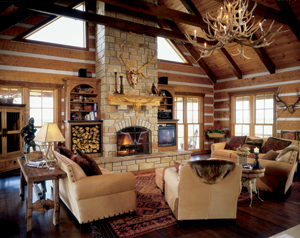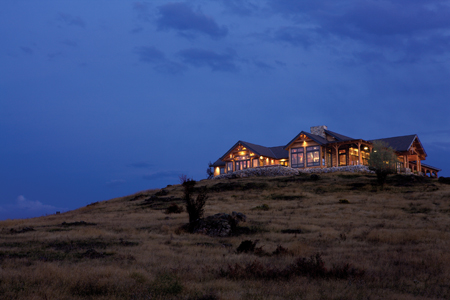For many, buying a log cabin home means owning their last home, because log cabins are the stuff of dreams—the place that will be the site of countless visits from the grandkids, summer evenings spent on the porch swing listening to crickets sing, and crisp winter nights sipping hot chocolate in front of a crackling fire. Dreams should never be left to chance. Keep these five essentials in mind as you shop for the log cabin producer who will fulfill yours.
1. Have land in hand before you start shopping floorplans
Nothing is more frustrating than finding the perfect floorplan only to discover that major modifications need to be made to fit it to the topography of your site. By the time you’re done, the floorplan
you fell in love with is unrecognizable. Before you open a log home provider’s catalogue of plans, show your representative photos of your land from every conceivable angle. Likely he or she will be able to start you off with the floorplans that will require minimal (if any) modification and that will best suit your property. If none of the designs jump out at you, then move on to other plans that will require modification, but keep in mind that changes can drastically alter the look and flow of a house. A custom-designed cabin is always an option, but typically will cost more money than a stock plan.
2. Don’t limit your options
In recent years, there’s been a lot of talk about how buying “locally” can save you money; however, when it comes to selecting a log home producer, this piece of advice can be misleading. For example, when one Northeastern Log Home (located in Kenduskeag, Maine) customer was planning to build his log cabin in Colorado Springs, Colorado, he looked to regional manufacturers and handcrafters, but none of them produced the kind of log home he envisioned. “He discovered that he didn’t want the ‘big log’ look that’s prevalent in the Rockies,” explains Dana Delano, Northeastern’s director of sales and marketing, “so he looked to the East. Not only did our company’s product fit his picture of a log home, it only cost about
$2,500 to ship the materials across the country. In the end, his home cost less than the ‘local’ packages he found, even with shipping. He got the look he wanted at the price he could live with, and he couldn’t be happier.”
3. Make a personal connection
Choosing a log home provider is kind of like dating. First, there has to be a physical attraction (i.e., you have to find a company’s product appealing), but ultimately, you need to make a real, personal connection before you make the ultimate commitment because, just like dating, you’ll be spending a lot of time with the people who will be drafting and crafting your log cabin home. Find a representative you feel comfortable with and trust—someone who’s going be with you through the whole process from milling to move-in day and who will take the time to walk you through all the decisions in between.

StoneMill Log Homes/photo by Roger Wade
4. Take a field trip
Once you’ve narrowed the producer field down to a handful of companies, one of the best ways to determine which
log home manufacturer is right for you is to pay a personal visit to each office and mill. You’ll get a glimpse of how those on your short list run their operations, and, if you’re lucky, you may even see another customer’s dream home taking shape on the miller’s blade. If the mill isn’t exactly buzzing while you’re there, don’t automatically take that as a sign that the company is in trouble. Like any business, log home producers have high and low periods of activity. If possible, arrange your visit so you can see the team in action.
5. Get a second opinion
First, ask for references—and then call them. It seems like a no-brainer, but you’d be surprised how many buyers fail to do this simple step. And even though it may be true that a log cabin manufacturer isn’t going to give you the name and number of a dissatisfied customer, there’s nothing like hearing what you can expect from a manufacturer straight from the source.
Second, make sure the reference lists you receive include both recent customers and ones who’ve been in
their homes for at least five years. As in any industry, log home manufacturers experience turnover, so folks who bought their homes recently can clue you in as to how it was to work with the current team. Customers who purchased their homes five or more years ago will be in a better position to convey how well the company’s craftsmanship holds up over time.
The final piece of this puzzle is to contact the Better Business Bureau to inquire about complaints against the companies you’re considering. If a complaint against a manufacturer has been logged, don’t simply cross it off your candidate list. Evaluate the severity of the complaint and weigh it against all the
other information you’ve gathered. In our sue-happy society, some customers are simply impossible to please and eager to point fingers. In the end, follow your instincts and you can’t go wrong.

